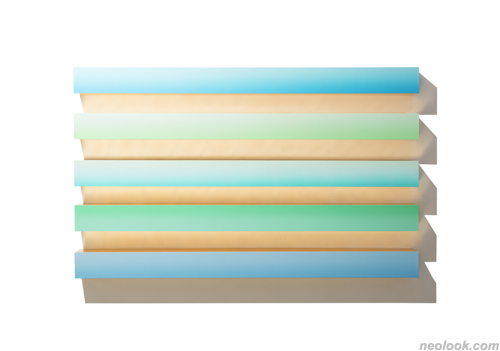- ● homepage
- ● archives
- ● restoration
- ● books
- ● big banners
- ● post board
- ■ neo's search
- ■ about us
- ■ 게재방법 안내
- 개인정보처리방침

- [email protected]
- Tel. 02_335_7922
- Fax. 02_335_7929
- 10:00am~04:30pm
- 월요일~금요일
- 3/3(월) 대체공휴일

echo of Light 빛의 울림
박현주展 / PARKHYUNJOO / 朴昡姝 / installation 2018_0131 ▶ 2018_0225 / 화요일 휴관
● 위 이미지를 클릭하면 네오룩 아카이브 Vol.20160930i | 박현주展으로 갑니다.
초대일시 / 2018_0131_수요일_05:00pm
관람시간 / 10:30am∼06:30pm / 화요일 휴관
통인옥션갤러리 TONG-IN Auction Gallery 서울 종로구 인사동길 32(관훈동 16번지) 통인빌딩 5층 Tel. +82.(0)2.733.4867 www.tongingallery.com
박현주 작업에 관하여; 암시(暗示, allusion) ● 작업은 "회화는 무엇인가?"에서 출발한다. 그린다는 것은 대상, 빛, 본질과 같은 근본적인 물음을 담고 있다. 더불어 작가에게 삶의 의미는 작업의 문제와 연결되어 있다. 회화의 문제에서 출발한 작가의 존재론적 사유는 지속적이다. 작업의 과정은 삶을 성찰하는 과정이며 삶의 의미가 녹아있다. 작업과 삶을 주체적으로 사유하며 전개한다. "어디서 와서 어디로 가는가?" 작가는 생의 근본적인 질문의 해답을 작업에서 찾는다.
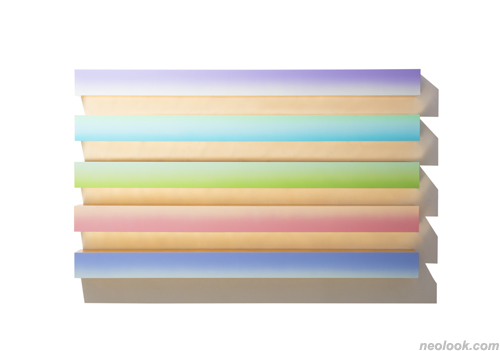
- 박현주_Light Monad (LM)5-2_나무, 아크릴채색, 금박_100×160×12cm_2017
삶을 회의(懷疑)한다. 작가의 화면은 삶의 존재적 성찰로 '내면의 풀리지 않는 응어리'와 '막다른 골목에 선 인간'의 실존적 한계를 담고 있다. 그리고 그리움을 시각화하고 자연으로부터 영감을 얻어 「변형된 생명체metamorphosis」를 1996년에 발표한다. 식물과 씨앗과 같은 변형된 생명체를 나타내던 검은 점은 선에서 면으로 확장한다. 작업의 재료인 흑연의 반사면은 성상화 연구에서 경험한 금박의 반사면과 닮아 있다. 작가는 두 반사면에서 환영의 시각적 효과와 빛 자체가 화면에 안에 있음을 확인한다. 반사 빛이 만든 미지의 시각적 환영을 바라보는 것은 매혹의 순간이다. 작가는 자신을 매혹하는 반사된 빛의 세계를 생명체 내부에 잠재된 생명 에너지의 암시(allusion)로 해석한다.
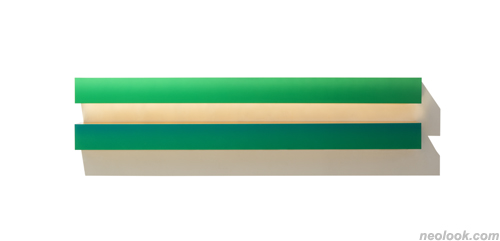
- 박현주_Light Monad (LM)green_나무, 아크릴채색, 금박_36×160×12cm_2017
작가가 집중하는 빛의 반사는 숭고한 아름다움을 간직하고 있다. 비잔틴 이콘(Icon)이나 르네상스 성상화(聖像畵)의 황금빛 배경은 천국의 영원성과 신성한 공간을 상징한다. 작가는 프라 안젤리코(Fra Angelico, 1395-1455)의 감실(Tabernacle) 제단화 「리나이올리 성모자상Linaioli Madonna」 연구에서 금박기법을 체득한다. 금박기법은 간접적으로 드러나는 빛의 반사가 만드는 신비한 아름다움을 창출한다. 금빛 아우라(aura)가 담긴 반사는 물리적 현상과 심리적인 현상을 동반한다. 금박의 반사를 활용한 작업은 새로운 공간의 확장에 주목하며 설치작업으로 이어진다. 작가는 보는 거리, 각도, 조명의 상황에 따라 변화하는 작품을 공간 안에 들어가 감상자가 다양한 시점에서 체험하기를 기대한다. 눈으로 읽는 것과 읽히지 않는 것 사이에 있는 중간 상태에 집중한다. 작가는 입자와 파동의 성질을 가진 빛의 물리적 현상 너머 그리고 표면의 물성 위에 부유하듯 흐르는 추상적인 것을 포착한다. 작업은 추상적이며 은유적인 아름다움과 존재 너머의 신비한 경험을 포함한 무한의 것을 표현하는 것이다.
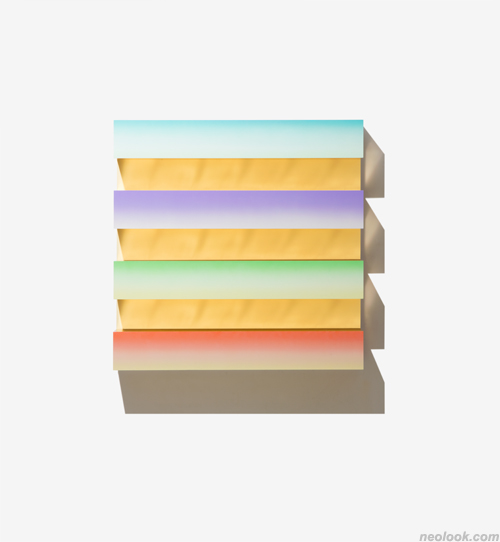
- 박현주_LightMonad (LM) 4-2_나무, 아크릴채색_78×80×12cm_2017
성상화(聖像畵) 제작 연구를 심화한 작업 「빛으로부터Inner Light」은 자기성찰과 물성에 관한 표현을 동반한다. 성상화는 금박과 템페라로 화면을 나누어 제작한다. 두 기법의 경계는 무한의 신성과 유한의 인성, 금박의 물성과 회화의 평면성으로 조형의 독자적인 창작 방법론을 작가에게 제공한다. 화면 속에 경계를 이루는 금박의 물질성과 템페라의 채색은 박현주 작업의 열쇠이다. 작가의 조형세계는 평면과 입체, 물성과 상징성 그리고 반사와 환영의 관계를 파악하고 확장한다. 「변형된 생명체」에서 유기적 생명체의 형상을 제거한 연작 「빛으로부터」는 회화의 '평면성(a plane surface)'과 '빛의 반사'에 초점을 맞춘다. 작가는 평면성과 빛의 반사를 하나의 주제로 다루며 '회화적 오브제Plane Object'라고 부른다. 회화의 평면성과 빛의 반사를 함께 표현한 독자적인 조형론을 펼친다. 전통적인 회화의 평면성을 해체하고 텅 빈 표면 앞에 작가는 자신을 돌아본다. 반사 빛이 사물의 표면에서 벗어나 만든 신비한 환영의 공간을 재현한다. 작업은 회화 안에서 물성을 다룬다. 육면체의 네 측면에 금박을 입힌 '회화적 오브제'는 놓이는 공간과 빛의 관계에 따라 가변적으로 작동한다. '회화적 오브제'는 빛을 받으면서 사물이 가지는 물성을 상실하고 평면화된다. 지지대와 바탕칠 그리고 물감층이 하나의 물질적인 구조로 미묘한 색다른 공간을 연출한다.

- 박현주_LightMonad (LM)black_나무, 아크릴채색, 금박_12×40×12cm×3_2017
작가는 남산골로 작업실을 옮긴 후 숲길을 걷는다. 소나무와 더불어 다양한 나무의 기운을 받고 나무의 정령을 체감하며 명상한다. 작가는 개념을 끄집어내는 것이 아니라 무의식적인 생각을 없애려고 한다. 작업의 태도는 명상의 태도와 닮아있다. 작가와 작품은 작업과정에서 주체와 객체로 서로 교차하며 만난다. 주체로서의 작가와 대상으로서 작품이 서로 영향을 주고받으며 어느 순간 하나 됨을 확인한다. 특히 금박으로 작업을 진행하던 과정은 시공간 속으로 주체와 객체가 녹아 사라짐을 체험한다. 인식의 주체와 객체 사이의 경계가 무너진 지점에 박현주의 '회화적 오브제'가 자리한다. '회화적 오브제'는 회화의 평면이 창출하는 자아의 은유(metaphor)이다. 물성이 사라진 캔버스는 물질과 정신의 경계에서 '자아의 은유'를 상징하는 새로운 개체로 탈바꿈한다. 즉, 하나의 단위(unit)를 만든다. 몇 개의 단위로 구성된 '회화적 오브제'는 반복적으로 벽면에 설치된다.
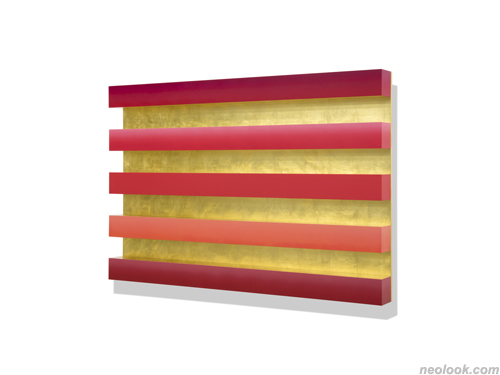
- 박현주_LM5-3_나무, 아크릴채색, 금박_81×120×9cm_2017
작품은 자아의 투영이다. 작업은 자기 얼굴을 비추는 거울과 같다. 한 발짝 뒤로 물러선 거리에서 자기를 바로 보게 한다. 작가는 평면을 오브제로 만들어 대상화(objectify)한다. 오브제의 의미는 작가에게 객체이며 대상이다. 기존의 회화 작품을 지지대, 바탕칠 그리고 물감층이 하나의 물질적인 구조로 파악한다. 사각형 캔버스의 측면을 넓혀 육면체라는 구체적인 오브제로 변환하여 '회화적 오브제'를 만든다. 일정한 거리를 두고 주체인 작가와 대상인 작품을 동일 선상에 놓고 본다. 작가 자신과 작품을 대상화하는 과정은 세계가 전체로서 하나임을 인식하는 방편이다. 박현주의 작업은 작가와 대상 사이에 간극을 너머 일체화된 관계를 보여준다. 주체와 객체의 경계선 허물기이며 서로의 만남이다. ● 빛은 존재를 반사한다. 박현주의 작업은 물질 너머의 존재를 암시한다. '회화적 오브제'는 현실과 비현실, 물질과 정신, 주체와 객체의 불협화음에서 생명에너지가 가득한 조화를 소망한다. 빛의 반사를 담아 전체로서 하나인 조형의 세계를 기대하며 삶의 무게를 덜어줄 위로의 세계를 제안한다. 빛의 환영이 만든 아우라의 세계는 스스로 그러한 자연스러운 모습으로 함께 마주한다. ■ 김대신
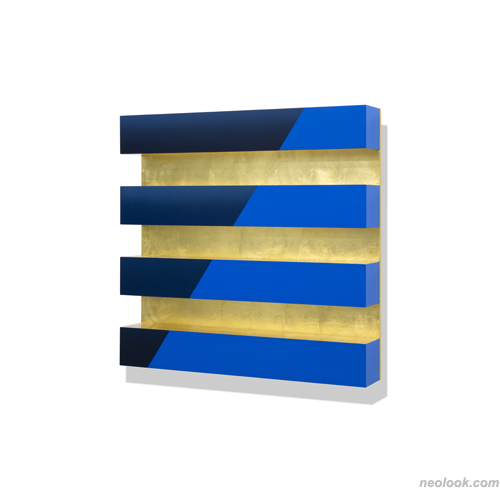
- 박현주_LM4-5_나무, 아크릴채색, 금박_78×80×12cm_2017
About Park's work ; allusion ● The artist's work starts from "What is painting?" Painting includes fundamental questions about the object, light and the essence. Furthermore, the meaning of life in the eyes of the artist is related to her work. Her ontological deliberation about painting is continuous. The process of work is a process of introspecting life and it includes the meaning of life. The artist ponders about her work and life in an autonomous way. "Where do we come from and where do we go?" Park seeks the answer to that query by her work. ● Park doubts about life. The artworks represent the feeling of resentment and the feeling of helplessness found through the existential retrospection of life. The artist also visualized longing and got inspirations from nature, and exposed Metamorphosis in 1996. A black spot that represents metamorphosis like a seed and plant expands into a line and into a plane. The reflective surface of graphite resembles with the reflective surface of gilt religious paintings. The artist believes that the visual effects of the illusion of these two reflective surfaces and the light itself are inside the painting. Contemplating the visual illusion made by the reflective surface is a moment of fascination. The artist interprets this fascinating world of reflected light as an allusion of life energy. ● The reflection of light which the artist is focusing on preserves a sublime beauty. The golden backgrounds of Byzantine Icon or religious Renaissance paintings symbolize the eternity of paradise and the holiness of the place. Park acquired the skills of gilding by the tabernacle 「Linaioli Madonna」 of Fra Angelico. Gilding creates a numinous beauty through the reflection of light. The golden aura inside the reflection has a physical and psychological effect. The work using gilding's reflection is focusing on the expansion of new space and is connected to installation art. The artist expects the viewer to enter inside the space and experience artworks that change depending on the distance, angle and lighting. Park focuses on the intermediate state between the visible and the invisible. Park captures beyond the physical phenomenon of light, which has wave-particle duality and captures the abstractness that float upon the surface of its properties. Her work is abstract and represents the infinity comprising the experience beyond the metaphorical beauty and the existence. ● The deeper study about religious paintings 「Bicheurobuteo, Inner Light」 accompanies introspection and representation of properties. The gilding part and the tempera part of religious paintings are divided during the painting process. The limit between the two techniques, with the infinite divinity and the finite humanity, the properties of the golden leaf and the flatness of the painting, offers the artist an independent way of artistic creation. The key of Park's work is the boundary between the property of the gold leaf and the tempera painting. The plastic arts of the artist understands the relation between the plane and the cubic world, the properties and the symbolism, the reflection and the illusion, and expands it. The series 「Bicheurobuteo」, which excludes organisms from 「Metamorphosis」, focuses on the painting's plane and the reflection of light. The artist treats planarity and reflection of light as a theme. It is called 'Plane Object'. She unveils her own formative theory expressing both the planarity of the painting and the reflection of the light. The artist dismantles the planarity of the traditional painting and self-reflects in front of a blank surface. The reflected light reproduces the space of a mysterious illusion made when getting out of the surface of the object. Her work deals with properties inside painting. The gilt 'Plane Object ', a cuboid with four gilt sides, varies with space and light. 'Plane Object ' becomes a plane by receiving light, and therefore losing the properties it originally had. With a structure where support, background and the upper layer covered with paint form one material thing it creates a subtle and original space. ● Park often strolls down a path in the woods after moving her workroom to Namsan-gol. Receiving the energy from pine trees and other various trees, she feels the spirits of trees as she meditates. She does not intentionally struggle for ideas, but tries to delete unconscious thoughts. Her attitude about artwork is similar to a meditative attitude. The artist and the artwork cross each other as subject and object in the work process. The artist as a subject and the artwork as an object interact together to be united together. Particularly, the gilding process is an experience where the subject and the object become one into space and time. Where the boundary between the subject of perception and the object has disappeared, stand Park's 'Plane Object '. 'Plane Object' are the self's metaphor created by the painting's surface. The canvas deprived of its properties on the boundary between matter and mind becomes a new object that symbolizes the self's metaphor. Therefore it forms one unit. 'Plane Object ' consisting of several units are repetitively installed on the wall. ● The artwork is the projection of the self. It is like a mirror reflecting one's own face. The viewer has to look at itself objectively from a certain distance. The artist transforms the plane into an object and objectifies it. To the artist, the meaning of the object in art is an object and stuff. She understands existing paintings as material structures with support, background and the upper layer covered with paint united together. By broadening the scope of her work, she moves beyond the canvas to a specific object, a cuboid, to make 'Plane Objects'. She places the subject, which is the artist and the object which is the artwork in line and keep a certain distance between them. The process of objectifying herself and the object is a way to perceive that the world is one as a whole. Park's work surpasses the gap between the artist and the object and shows a unity of the two. It is a collapse of the boundary between the subject and the object and is a meeting of them. ● Light reflects existence. Park's work implies the existence beyond substance. 'Plane Objects ' pursues a harmony full of life energy inside the disharmony between reality and the unreality, the matter and the esprit, the subject and the object. It proposes a world of consolation by keeping light reflection and expects an artistic world with one as a whole. The world of aura made by optical illusions faces the artist and the viewer naturally by itself. ■ Daesin KIM
Vol.20180131a | 박현주展 / PARKHYUNJOO / 朴昡姝 / installation

